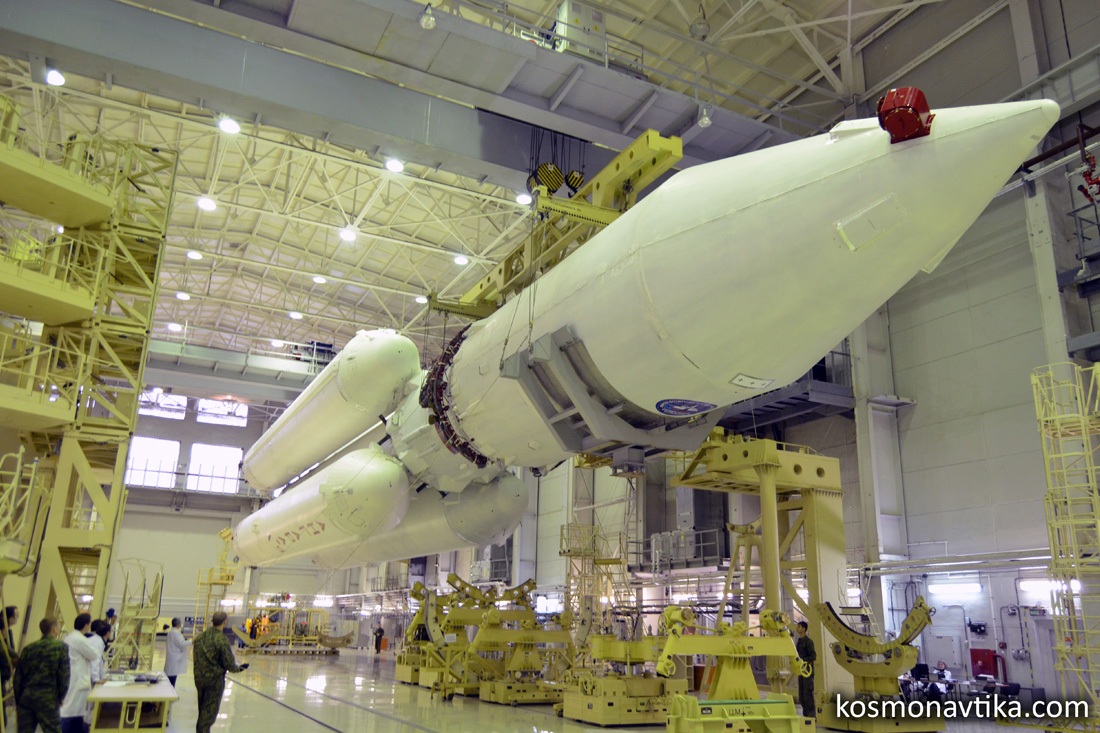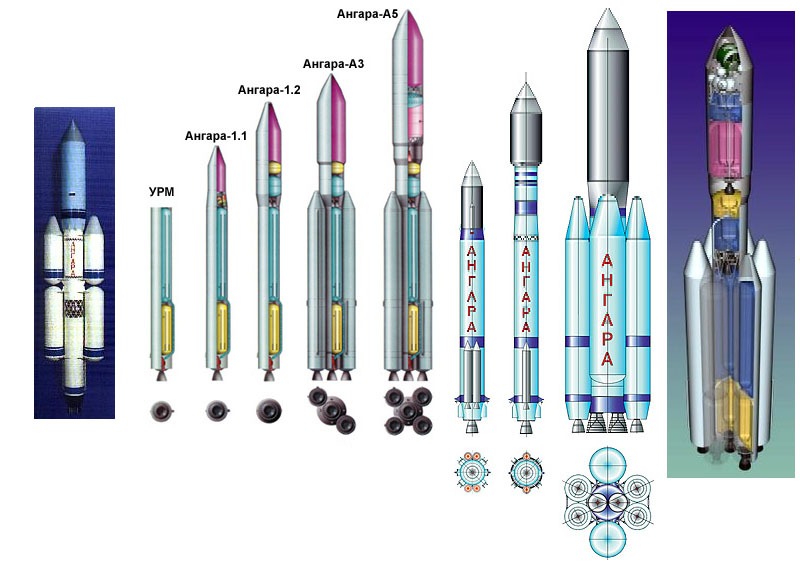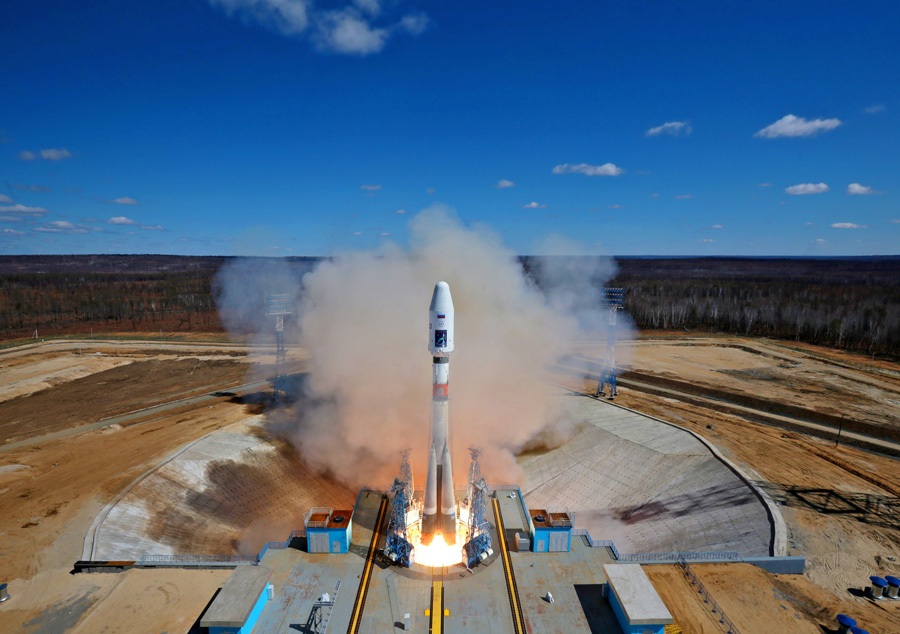Why does the country have a non-flying rocket and an empty cosmodrome

Russia has invested a great deal in the development of the Angara launch vehicle and in the construction of the Eastern cosmodrome. In recent years, the media have repeatedly recalled these projects, now in loud promises, now in triumphant reports, in the context of scandals. Unfortunately, the news about real achievements was significantly less than bravura and exposing hype. One Angara carried out an orbital launch two and a half years ago, one Soyuz flew from the Eastern one a year ago. And that's all.
The latest news: it looks like Angara will not be trusted even by the new manned ship Federation, which, according to very recent plans, was preparing to fly it to the Moon.
Even a person far from astronautics understands that a rocket must fly and a space launch center should be allowed. If both do not happen, then the matter is amiss. The question of what state billions left is repeated repeatedly in the media, in blogs, and in comments. Let's try to figure out why Roscosmos is non-flying and non-letting expensive toys.
This East-Angara theme should be considered as a complex, since they are now closely related, although they began as completely independent projects. It is important to understand that the current situation was a consequence of the unpredictable development of events over the past 20 years, to which Roskosmos responded. And do not forget that Roskosmos is not a human being, but a complex evolving structure, that practically no one who made decisions on the development of the Angara or the construction of the Eastern one now occupies those posts and does not affect today's decisions.
"Angara"
Just look at the line of rockets at different times designed by the name "Angara" to understand the long development time. The history of this rocket recalls the famous movie about the production of the Bradley BMP.

At first it was prepared on the starting table of the Zenith, which was already at Baikonur and Plesetsk. Then they began to design their own. Wings were attached to side accelerators to give reusability even when Ilon Musk learned to send dollars by e-mail. The concept of universal rocket modules - a promising topic of reducing the cost of production, was subsequently implemented by a young American startup SpaceX. In general, the history of "Angara" is an example of what can happen if you give developers an unlimited budget, unlimited time limits and say "Do it yourself!" And they made a rocket with universal modules for economy, but with three different launch tables for each modification A3, A5, A7, which raises the cost of the whole complex to the skies.
The only thing that accompanied the "Angara" throughout its life course - it is its uselessness. As a rocket, the Angara is not needed. And always was not needed. The Angara was always used for any other purposes besides launching spacecraft. For normal rocket work, existing missiles continued to be exploited: the capabilities of the A1 are “Dnepr”, “Rokot”, “Soyuz-U”, A3 is “Soyuz-2” and “Zenit”, A5 - “Proton”, A7 - loads of such not.
There are no commercial prospects either - the rocket is twice as expensive as the Proton.
The Angara began to gather cooperation, i.e. all manufacturers of components, after the collapse of the USSR. Then to load the work of designers, to feed them in the 90s, and not lose in principle the ability to develop missiles. Along the way, we have worked on all sorts of exotic cruise options, because we can and give money. By the end of the work, the rocket acquired propaganda value - Russian, eco-friendly, its own. At the time of the start of the heavy modification of the Angar A5, a new role emerged, which eventually became the main one, defining today's fate - political.
The first orbital heavy launch of the Angara was unique in the history of Russian astronautics - it was allowed two days earlier than the appointed date. After years of postponement, but two days earlier than the announced date. Accurate on the day when President Nursultan Nazarbayev of Kazakhstan visited Russia on a state visit.
Oriental
The decisive factor in the construction of the East was that Baikonur is not ours. By the beginning of the 2010s, the basis of the strategy of Roscosmos appeared - guaranteed access of the Russian Federation to space from its territory.
Russia and Kazakhstan signed an agreement on Baikonur in 1994. Under the terms, Russia pledged to pay $ 115 million annually. At the time of the conclusion of the contract, the young Kazakh republic, this compensation seemed acceptable, but then the country's economy grew and the contribution of Baikonur seemed ever more insignificant. At the same time, the cosmodrome is a restless neighbor. The spent first stages of rockets are constantly falling from the sky. Periodically over the cosmodrome something bahs, spreading suspicious brown clouds. And the Kazakh public is worried after reading the article " asymmetric dimethylhydrazine " in wikipedia. Rumors like "after the Russian launches the weather deteriorates" roam the country. In general, there is more reason to get from the cosmodrome Kazakhstan. You can push the ban to drop steps, a ban on launches after the accident, or just clear hints to terminate the contract.
Russian cosmonautics without Baikonur on one of Plesetsk will not fly away. Key features of Baikonur: launching tables of the Proton and manned tables of the Union. But so far, the United States does not dare to attack the United States on this rocket, but the Proton is like a thorn:
Poisonous - and no one is worried by the reports of environmentalists that toxic fuel does not affect nature - it does not have time to reach the ground.
Commercial — in the 90-2000s, the Proton pulled from one-third to one-half of the entire commercial space program of the world, and each launch was a little less for money than Kazakhstan gets for the space center per year.
The military - an independent achievement of the geostationary orbit opens up the possibility of permanent radar and optical monitoring of the territory of the whole world or selected regions.
In general, many would support Kazakhstan in its desire to pop the Russian "Proton".
And in this situation, Russia undertook to solve the problem. The decision may seem controversial, the classic pouring money, but now you can see - it works. Tactics "carrot and stick".
"Knut" and became "Angara" with the East. By launching a heavy rocket from its territory and building the Far Eastern cosmodrome, Russia made it clear to Kazakhstan and the rest of the world that it has its own “amusement park”, and it does not hurt to put pressure on the Proton.

In 2015, the Gingerbread was the flight of the only Kazakh cosmonaut Aydin Aimbetov, and the development of a joint project of the Baiterek cosmodrome. The project itself is already more than ten years old, but it became more active after the Angara flight and launch from the East, although the profitable Sunkar project became the decisive factor.
Now the "Angara" only one pad in Plesetsk. Created with the funds of the Ministry of Defense in order to ensure Russia's access to space from its territory. But Plesetsk is the worst cosmodrome for launching into a geostationary orbit — too much fuel is spent on changing the orbit inclination. On the East, for a long time, it was planned to build two launch sites for the A5 Angaras - one “cargo”, the second - manned. In this configuration and with the revision to the “Angara A5B”, it was possible by two launches to deliver the Russians in the “Federation” to the near-moon orbit. For this potential opportunity Roskosmos steadfastly kept in moments of the toughest sequester of the space budget. For the media, the formula about "ensuring the possibility of reaching the moon until 2030" was repeated.
I wanted to believe. Just a couple of months ago, despite the chaos with defective engines, debris in the fuel lines and slammed doors by astronauts, the prospect of joint operation by the end of the 20s of the American near-moon station still seemed real. Orion and the Federation docked to the station with a view of the moon. I would like to see this ...

But the Ministry of Finance came to no - luck - there is no money for two tables under the “Angara”, so there is no flight to the Moon, and there are no manned launches.
Phoenix / Sunkar
The Soviet, and later Ukrainian, Zenith rocket was quite successful for its time, and maintained high rates of economic and energy efficiency in the 21st century. In fact, it was the cheapest rocket for launches into the geostationary orbit, although it was losing in power and reliability to the Proton. She flew in the 90-2000th for commercial and government orders from Baikonur and from the floating cosmodrome SeaLaunch.

The Ukrainian rocket flew on the Russian RD-170 engine. The political conflict between Russia and Ukraine practically buried this project. But the success of “Zenith” and the revival of SeaLaunch under the auspices of the commercial company S7 prompted Roskosmos to work out a Russian rocket on the RD-170. The RSC Energia’s groundwork for the Rus rocket was taken as a basis. So the project "Phoenix" appeared. Kazakhstan gave money for this work, and a variant called "Sunkar" (Falcon) is being worked out for it. This rocket can be launched from the Zenith launch tables, i.e. significant capital costs are saved.
Most recently, the head of "Energy" spoke about the possibility of putting the spacecraft "Federation" on the "Phoenix", and today this is the only possible option. “Phoenix” is weaker than “Angara”, so for now no moon shines on our cosmonauts. But in the perspective of the five missiles, you can assemble the Pyatiphenix, and this will already be a lunar super-heavy rocket. Those. here the modular concept of the "Angara" is repeated, with the difference that each module is an independent rocket with an extensive range of tasks, unlike the inferior Angara UMM. The American Falcon-9 rocket is developing with the same ideology. Is it easy to assemble three or five from one rocket by the example of the triple Falcon Heavy - the launch was promised in 2014, in the yard of 2017 and promised by the fall. We'll see.

How sensible is the creation of a new rocket from scratch, when the analogous Angara is almost ready? Is it possible to believe that “Phoenix” will not turn into endless useless long-term construction like “Angara”?
Believing is not worth anything, but you can hope, and here's why:
1) If “Phoenix” works out with the price of “Zenith”, then it will be three times cheaper than “A5 Angaras”, with comparable launching possibilities, if you start from the equator on SeaLaunch.
2) "Phoenix" is not developed GKNPTs them. Khrunicheva, and RSC Energia, which has established itself as a quality manufacturer of Soyuz spacecraft and other technology. "Energy" is much less likely to get into reports of corruption scandals, the wages of workers in the enterprise have always been almost the highest in the industry. You can say nothing better than RSC Energia at Roskosmos simply does not.
3) Launching tables for Zenit at Baikonur are ready. SeaLaunch is ready to sail. Rejecting the two launch tables, "Angara" you can save money on the development of the "Phoenix" and still surrender to the lunar microsatellite remains.

4) At Phoenix there are private customers. The same S7 is already ready to buy and let.
5) The participation of Kazakhstan is encouraging. Now Russian space projects are successfully developing practically only in international programs. Much that is being done for oneself is infinitely long and with an unclear perspective. Much that in international - quality and on time, at least recently it was still so.
6) The project of the Kazakh-Russian cosmodrome "Baiterek" moved to a standstill only after Russia stopped trying to fob Angara on Kazakhstan and began a conversation over Phoenix.
Well, simple: "Phoenix" - is needed. Provided that it will be cheaper than "Proton". He needs both Russia and the global market. In fact, it is Russian Falcon-9, only without reusability, but with wings.
According to the latest news for the next 10 years, the picture emerges as follows:
1) The emerging transfer of Baikonur to the East is suspended.
2) Eastern is a really good modern cosmodrome , its only problem is that while there is Baikonur, it is not needed. Therefore, from the Far East, only to maintain their potential, they will start up rare “Unions” with commercial or scientific loads of 5-6 launches in the best years.
3) On the East, they build one launching table under the Angara and launch some military satellite from there once every two years, purely in order not to forget how to make a rocket and the table does not rust.
4) The Federation flies in the mid-20s to Phoenix / Sunkare from Baikonur, and only around the Earth. It may still have time to jump on the ISS.
5) Phoenix / Sunkar draws most of the potential Proton commercial orders, and flies from Baikonur and SeaLaunch, there is no or very little toxic missile, part of the profit goes to the local treasury and Kazakhstan is happy.
6) "Proton" continues to fly from Baikonur up to the stop, but rarely, until (and if) there is a government order and some heavy commercial satellites.
7) “Angara” is still not needed, and “stands on the siding,” and if “Phoenix” shows itself well, then it will be closed altogether.
8) Production of the Proton is taken out from Moscow to Omsk, the rare Angar is made there, on the site of the plant in the bend of the Moscow River in Fili, the residential complex Kosmos appears.
In the whole of this picture, the role of "TsiKh" - the Khrunichev State Research and Production Space Center is the saddest. The once-powerful production and science and technology center in the center of Moscow, which built satellites, rockets and space stations, is experiencing a long crisis, reorganization and scandals, loses all possibilities of lobbying its interests, therefore all changes that occur in Roskosmos on hand to a direct competitor - RKK " Energy".
It is important to understand that in this story there are no bad and good, everyone is trying to resist the coincidence of circumstances with the maximum benefit for themselves. Everything that happens with Roscosmos since 1991 is the result of the Soviet legacy. I have already paid attention that Roskosmos from the USSR received a tremendous industrial potential, which now works well if at 30% power. And all that the department has been doing for 25 years is not to lose the “bag, picture, basket, carton, and little dog”, and we want Roscosmos to run a sprint with all this stuff. In difficult years, work was on commercial orders and the Americans helped with their “international” station. Now they have lost both commercial orders, and the prospects for international cooperation with former partners, and their money is not enough.
The industry’s only hope of returning to the “golden age”, as in the 1980s, is oil at $ 150. No other factors will help. With this understanding, reform began a couple of years ago. Therefore, all that Roscosmos is engaged in is in a state of reform and budget cuts - these are reorganization, optimization, mergers and acquisitions, shrinking and commissioning, so it will not seem like much to anyone.
In general, I had a feeling that the super-heavy rocket and the Russians on the moon would be a bonus to Roskosmos for a successful reform. If we succeed in creating an efficient and compact industry that meets the needs of the state in near-Earth space and competes in the global market, then it will receive an appetizing order for the moon. And if not, well, that means no shmogla.
And do not cry for “Angara”, she came and left not in vain.
All Articles